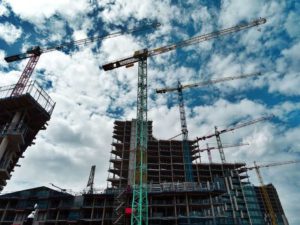According to Random Lengths, the price of lumber is up 188% since the start of the pandemic. The Producer Price Index shows that iron and steel scrap have skyrocketed 50.8%. Crude oil is up about 80%, just from October – which has caused oil-based products like paint, drainpipes and shingles to also spike.
Even the global semiconductor shortage is impacting construction, as trucks and heavy equipment manufacturers delay production schedules, and slow deliveries of appliances and other systems that rely on electronics are delaying project completion.

The forces driving these prices range from the obvious (COVID-19-related disruption), to the less obvious (a shipping container shortage). Planning has also been a culprit – as demand plummeted early in the pandemic, suppliers did not foresee the sudden spike in demand that would occur as people relocated from cities to less-congested suburbs.
In fact, shortly after suppliers cut production, new housing starts began to rise and are currently up 30% year-over-year according to the U.S. census.
All of this adds up to a tough season for contractors – the cost of materials is way up, the reliability of timely delivery is a crap shoot, and amid all of this, the dramatically increasing value of the assets lying around the worksite are a crime magnet.
The Site Security Mandate
We’ve detailed before the best security practices for keeping construction sites crime-free. With today’s dramatic increase in the value of materials on jobsites, it’s never been more important to follow these practices. Key things to remember include:
-
Create a perimeter barrier − Fencing is the most common barrier and can be complemented with the presence of security guards. However, security guards are the most expensive way to secure a construction site and may not be viable or effective in times when materials prices are high and putting downward pressure on margins.
-
Secure heavy equipment − Re-keying equipment and adding GPS tracking can keep heavy equipment safe. As with security guards, this could be a difficult cost for some firms to bear.
-
Use good lighting − Criminals hate light, so keeping the job-site well-lit is a good deterrent.
-
Keep Supplies Lean − The fewer supplies on site, the less there is to steal.
-
Use Remote Video Monitoring Services − The most cost-effective way to actively deter crime is to use a Remote Video Monitoring Service (RVMS). Standalone cameras can help to identify criminals after the crime has been committed, but they are not an effective crime deterrent. When coupled with RVMS, however, the system becomes a pre-emptive crime deterrent through the instant identification of intruders, the use of audible and visual deterrents to drive them off the site and, if appropriate, the ability to notify police. Pro-Vigil provides these capabilities both in fixed and mobile deployment options. The mobile solution runs on solar power and does not require Wi-Fi connectivity, making it easy to deploy 24x7 active protection in a matter of hours.
These will be trying times for construction firms as they try to keep projects on budget and on schedule amid price spikes and delivery delays. Investing in site security can eliminate yet another source of disruption and margin erosion: criminals seeking to cash in on valuable construction materials and equipment.
To learn more about how Pro-Vigil can secure your construction sites, contact us today.






